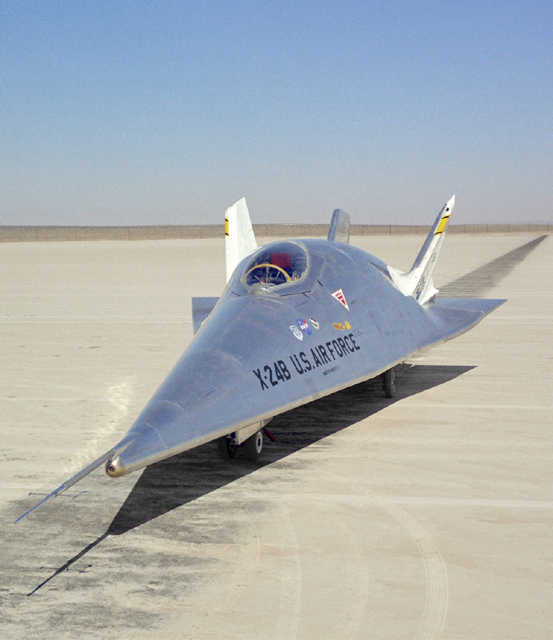Space History Photo: X-24B on Lakebed

In this historical photo from the U.S. space agency, the X-24B is seen here on the lakebed at the NASA Dryden Flight Research Center, Edwards, California, in January of 1973. The X-24B was the last aircraft to fly in Dryden's Lifting Body program. Lifting bodies were wingless vehicles designed to fly back to Earth from space and be landed like an aircraft at a pre-determined site.
First to fly the X-24B was John Manke, conducting a glide flight on August 1, 1973. He was also the pilot on the first powered mission on November 15, 1973. Among the final flights with the X-24B were two precise landings on the main concrete runway at Edwards which showed that accurate unpowered reentry vehicle landings were operationally feasible. These missions were flown by Manke and Air Force Maj. Mike Love, and represented the final milestone in a program that helped write the flight plan for today's Space Shuttle program.
The final powered flight with the X-24B was on September 23, l975. The pilot was Bill Dana, and it was also the last rocket-powered flight flown at Dryden. It was Dana who also flew the last X-15 mission about seven years earlier. Top speed reached with the X-24B was l,l64 mph (Mach l.76) by Love. The highest altitude reached was 74,100 feet, by Manke.
The information the lifting body program generated contributed to the data base that led to development of today's Space Shuttle program. The X-24B is on public display at the Air Force Museum, Wright-Patterson AFB, Ohio.
Each weekday, SPACE.com looks back at the history of spaceflight through photos (archive).
Get the Space.com Newsletter
Breaking space news, the latest updates on rocket launches, skywatching events and more!
Join our Space Forums to keep talking space on the latest missions, night sky and more! And if you have a news tip, correction or comment, let us know at: community@space.com.

The National Aeronautics and Space Administration (NASA) is the U.S. government agency in charge of the civilian space program as well as aeronautics and aerospace research. Founded in 1958, NASA is a civilian space agency aimed at exploring the universe with space telescopes, satellites, robotic spacecraft, astronauts and more. The space agency has 10 major centers based across the U.S. and launches robotic and crewed missions from the Kennedy Space Center in Cape Canaveral Florida. It's astronaut corps is based at the Johnson Space Center in Houston. To follow NASA's latest mission, follow the space agency on Twitter or any other social channel, of visit: nasa.gov.









